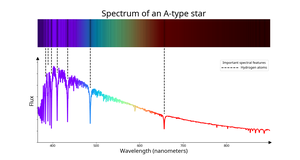Glossary term: A-type Star
Description: A star with spectral type "A". Astronomers identify A-type stars by the presence of strong absorption lines from hydrogen in their spectra. They have typical (effective) temperatures between around 7400 kelvins (K) and 10,000 K. Compared to other stars, they appear white or bluish white to human eyes unless affected by interstellar or atmospheric reddening. Sirius, the brightest star in the night sky, and Vega, the star against which all other stars' brightnesses are measured in the apparent magnitude scale, are A-type stars.
Related Terms:
See this term in other languages
Term and definition status: This term and its definition have been approved by a research astronomer and a teacher
The OAE Multilingual Glossary is a project of the IAU Office of Astronomy for Education (OAE) in collaboration with the IAU Office of Astronomy Outreach (OAO). The terms and definitions were chosen, written and reviewed by a collective effort from the OAE, the OAE Centers and Nodes, the OAE National Astronomy Education Coordinators (NAECs) and other volunteers. You can find a full list of credits here. All glossary terms and their definitions are released under a Creative Commons CC BY-4.0 license and should be credited to "IAU OAE".
If you notice a factual error in this glossary definition then please get in touch.
Related Diagrams
Spectrum of an A-type star
Credit: IAU OAE/SDSS/Niall Deacon
License: CC-BY-4.0 Creative Commons Attribution 4.0 International (CC BY 4.0) icons









